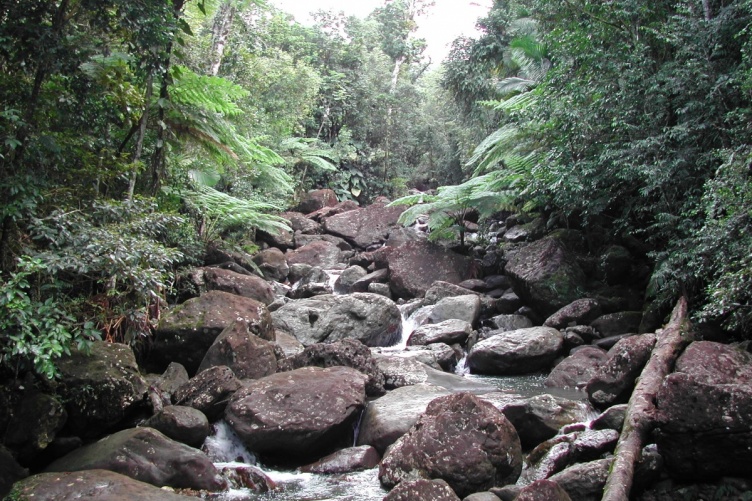
The Quebrada Sonadora stream in the Luquillo Mountains of Puerto Rico, which McDowell monitors for nitrogen. Photo by Bill McDowell/UNH.
A new analysis of hundreds of experiments co-authored by UNH professor of natural resources Bill McDowell shows fertilizer pollution can have ripple effects in the food webs of streams and rivers, spurring algae growth that feeds insects as well as the fish that feed on the insects.
The analysis, published in Biological Reviews, combined the results of 184 studies drawn from 885 individual experiments around the globe that investigated the effects of adding the nutrients nitrogen and phosphorus, the main components of fertilizer, to streams and rivers. While they only included studies where scientists added nitrogen and phosphorus experimentally, nitrogen and phosphorus pollution can run off from farms, lawns and wastewater discharge into streams, lakes and rivers. At high levels, fertilizer pollution can cause harmful algal blooms and can lead to fish kills.
“This study provides a detailed and statistically rigorous assessment of whether, when one adds nutrients — nitrogen and phosphorus — to an aquatic system, the effects go beyond algae growing too fast,” says McDowell. “We found that yes, they do: This increase in algal production translates to higher organisms” like insects and fish.
“Wherever we looked, we saw increases in the abundance and biomass of organisms that live in streams, and also the speeding up of processes that happen in streams – how fast algae grow, how fast leaves decompose and how fast organisms grow that feed on them,” says lead author Marcelo Ardόn, associate professor of forestry and environmental resources at North Carolina State University.
In shaded streams where algae don’t grow, the researchers reported nitrogen and phosphorus sped decomposition of leaves and boosted growth of organisms that feed on them.
McDowell and his co-authors saw an average 48 percent increase overall in biomass abundance and activity in all levels of the food web, and found that across all organisms and activities, responses were strongest when both nitrogen and phosphorus were added together.
“Both nutrients affect — typically negatively — the health of aquatic ecosystems and alter food webs. Reducing nutrient inputs of both nitrogen and phosphorus is almost always a good strategy,” says McDowell.
McDowell was among 18 authors who contributed to the study, a meta-analysis of individual studies that hunted for patterns in the data. “We all worked on harvesting datasets from the literature, which was a laborious, time-consuming process,” McDowell says, adding that the idea for the paper grew out of a workshop at a meeting of the Society for Freshwater Science. “This paper attempts to address one of the challenges for us in environmental sciences, which is to draw generalizable conclusions from a big range of individual studies.”
The study could affect environmental policy nationally and locally in Great Bay, McDowell says, by helping regulators better understand how to effectively reduce nutrient runoff into streams.
This research was funded by the National Science Foundation under grant DEB-0832653 through the Long Term Ecological Research Network Office. Individual authors were funded by the National Science Foundation under grant DEB-1713502, and the Department of Energy’s Office of Science, Biological and Environmental Research.
-
Written By:
Beth Potier | UNH Marketing | beth.potier@unh.edu | 2-1566


















































